Statistics
2017 Health Manpower Survey
Summary of the Characteristics of Radiographers
I. Radiographers Covered
The radiographers covered in the 2017 Health Manpower Survey (HMS-RG) includes both diagnostic and therapeutic radiographers.
1.1 Diagnostic Radiographers
1.1.1 Diagnostic radiographers refer to those radiographers (Category D) registered with the Radiographers Board of Hong Kong under the Supplementary Medical Professions Ordinance (Chapter 359) as at the survey reference date of 31 March 2017.
1.1.2 The number of diagnostic radiographers covered was 1 817.
1.1.3 Of the 1 817 diagnostic radiographers covered, 611 responded to the HMS-RG, giving an overall response rate of 33.6%. Among the respondents, 556 (91.0%) were economically active * † (active) and 55 (9.0%) were economically inactive* ‡ (inactive) in the local diagnostic radiography profession (Chart A) .
1.1.4 Of the 556 active diagnostic radiographers enumerated, 552 (99.3%) were practising in the local diagnostic radiography profession and four (0.7%) was seeking job during the 30 days before the survey. The survey results presented in paragraph 1.1.6 below were based on the 552 responding diagnostic radiographers who were practising in the local diagnostic radiography profession as at 31.3.2017. The percentages presented below may not add up to 100% due to missing responses or rounding.
1.1.5 Of the 55 inactive diagnostic radiographers enumerated, 14 (25.5%) reported practising overseas, six (10.9%) reported practising in the Mainland and 35 (63.6%) reported not seeking job in the local diagnostic radiography profession during the 30 days before the survey (Chart A). Among the 35 inactive diagnostic radiographers who reported not seeking job, the main reasons reported for not seeking jobs included: 21 (60.0%) were working in other professions, seven (20.0%) were retired, three (8.6%) were engaged in household duties and four (11.4%) reported undertaking study, wanted to take rest / had no motive to work/ had no financial need, etc.
* In the survey, the criteria used in defining economically active / inactive followed those recommended by the International Labour Organization, which are also being used by the Census and Statistics Department in Hong Kong.
† "Economically active" diagnostic radiographers comprised all "employed" and "unemployed" diagnostic radiographers. "Employed" diagnostic radiographers referred to those diagnostic radiographers practising in the diagnostic radiography profession in Hong Kong during the survey period, while "unemployed" diagnostic radiographers referred to those diagnostic radiographers who (a) were not practising in the diagnostic radiography profession during the survey period; (b) had been available for work during the seven days before the survey; AND (c) had sought work in the diagnostic radiography profession during the 30 days before the survey.
‡ "Economically inactive" diagnostic radiographers comprised the diagnostic radiographers who were not practising in the diagnostic radiography profession in Hong Kong during the survey period, excluding those who had been on leave during the survey period and who were "economically active" "unemployed".
Chart A : Activity Status of Diagnostic Radiographers Covered
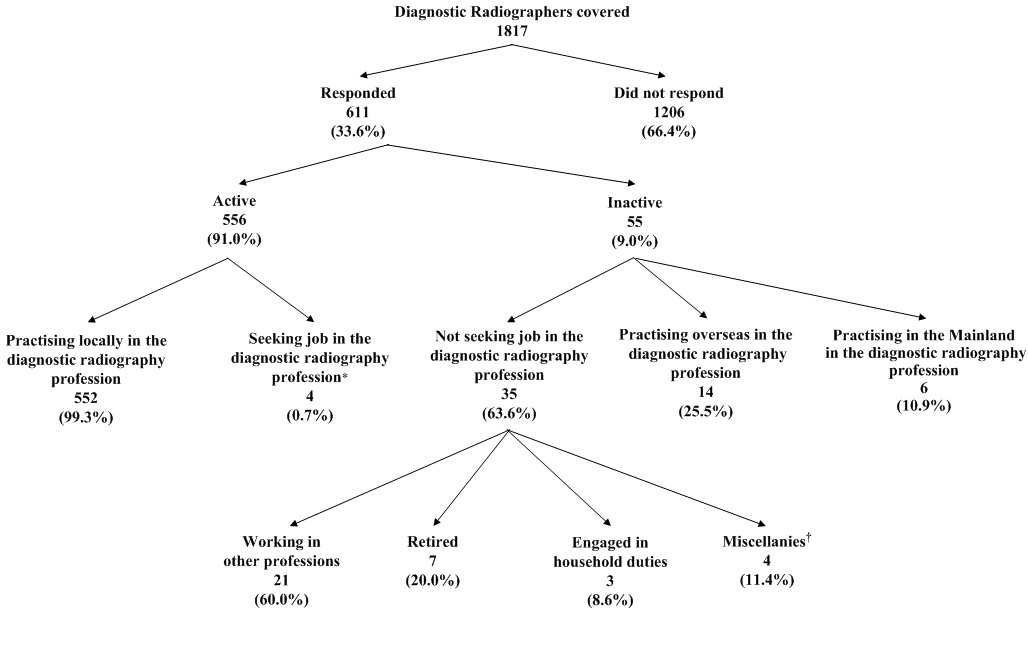
|
Note:
|
* | Figure refers to the number of responding diagnostic radiographer who (a) was not practising in the diagnostic radiography profession in Hong Kong during the survey period; (b) had been available for work during the seven days before the survey; AND (c) had sought work in the local diagnostic radiography profession during the 30 days before the survey. |
|
|
† | Figure refers to the number of responding diagnostic radiographers who reported undertaking study, wanted to take rest / had no motive to work/ had no financial need, etc. |
1.1.6 One active diagnostic radiographer did not indicate the gender. Among the remaining 551 active diagnostic radiographers enumerated, 277 (50.3%) were male and 274 (49.7%) were female, giving an overall sex ratio (males per 100 females) of 101.1. Apart from six active diagnostic radiographers who did not indicate the age, the median age of the remaining 546 active diagnostic radiographers enumerated was 45.0 years. The median age of the active female diagnostic radiographers enumerated were 47.0 years and that of their male counterparts was 41.0 years.
1.1.7 The responding active diagnostic radiographers were requested to indicate the characteristics of their main jobs*. Distribution by sector for the main job showed that largest proportion 262 (both 47.5%) of the active diagnostic radiographers were working in the Hospital Authority and the private sector, followed by 28 (5.1%) in the Government, academic and subvented sectors. Among the 262 active diagnostic radiographers enumerated who were working in the private sector, the largest proportion (52.7%) were working in medical and X-ray laboratory, followed by those working in private hospital† (42.4%) and miscellaneous health services centre (3.4%).
1.1.8 The median age of the active diagnostic radiographers enumerated was 48.0 years for those working in private sector, followed by the Government, academic and subvented sectors (45.0 years) and the Hospital Authority (40.5 years).
1.1.9 Of the 552 active diagnostic radiographers enumerated, 91.7% spent most of their working time on diagnostic stream, whilst 6.2% and 1.1% on administration / management and teaching respectively.
1.1.10 The median number of hours of work (excluding meal breaks) per week of the 552 active diagnostic radiographers enumerated was 41.5 hours. Among them, 131 (23.7%) were required to undertake on-call duty (excluding normal duty), with a median of 20.0 hours of on-call duty (excluding normal duty) per week.
1.1.11 Of the 552 active diagnostic radiographers enumerated, 51.3% held Bachelor’s Degree, 26.1% held Professional Diploma, 11.4% held Certificate, 7.1% held Higher Certificate and 3.4% held Diploma as their earliest basic qualifications.
1.1.12 Of the 552 active diagnostic radiographers enumerated, 348 (63.0%) had received / were receiving additional training. Of the 348 active diagnostic radiographers with additional training, 12 (3.4%) had not yet completed the additional training, 172(49.4%) held Master’s Degree, 68 (19.5%) held Bachelor’s Degree and 62 (17.8%) held Certificate / Post-experience Certificate / Post-registration Certificate as the highest qualification.
* Main jobs referred to the jobs in which the diagnostic radiographers had spent most of their working time.
† Refers to private institutions licensed under the Hospitals, Nursing Homes and Maternity Homes Registration Ordinance (Chapter 165).
1.1.13 Of the 348 diagnostic radiographers who had received / were receiving additional training, 227 (65.2%) had received / were receiving training in one field only. Among them, 36.6% had received / were receiving training in diagnostic radiography, 24.2% in ultrasonography / medical ultrasonography, 18.1% in healthcare (medical imaging and radiation technology), 4.8% for each field in magnetic resonance imaging and nuclear medicine / nuclear medicine technology, 4.4% in healthcare management / health services management and 2.6% in computer radiography.
1.1.14 Among the 348 diagnostic radiographers enumerated who had received / were receiving additional training, some of them selected more than one field of additional training. The total number of count of active diagnostic radiographers who had received / were receiving additional training was 510, in which 31.4% were trained / receiving training in diagnostic radiography, 18.0% in healthcare (medical imaging and radiation technology), 17.8% in ultrasonography / medical ultrasonography, 12.4% in magnetic resonance imaging, 7.1% in healthcare management / health services management, 5.5% in nuclear medicine / nuclear medicine technology and 2.5% in computer radiography.
1.1.15 Regarding Continuing Professional Development (CPD) activities, 320 (58.0%) of the active diagnostic radiographers reported that they had participated in CPD activities in 2017, 216 (39.1%) reported no participation in any CPD activities, whilst 16 (2.9%) did not report whether they had participated in CPD activities or not. Among the 320 active diagnostic radiographers who had participated in CPD activities, the distribution of CPD credits attained in the past 12 months was: 1 to 10 credits (48.8%), 11 to 20 credits (31.3%), 21 to 30 credits (9.1%), 31 to 40 credits (4.7%) and more than 40 credits (6.3%).
1.2 Therapeutic Radiographers
1.2.1 Therapeutic radiographers refer to those radiographers (Category T) registered with the Radiographers Board of Hong Kong under the Supplementary Medical Professions Ordinance (Chapter 359) as at the survey reference date of 31 March 2017.
1.2.2 The number of therapeutic radiographers covered was 363.
1.2.3 Of the 363 therapeutic radiographers covered, 113 had responded to the HMS-RG, giving an overall response rate of 31.1%. Among the respondents, 100 (88.5%) were economically active * † (active) and 13 (11.5%) were economically inactive * ‡ (inactive) in the local therapeutic radiography profession (Chart B) .
1.2.4 Of the 100 active therapeutic radiographers enumerated, 96 (96.0%) were practising in the local therapeutic radiography profession, two (2.0%) were seeking job in the local therapeutic radiography profession, and two (2.0%) believed that work was not available or was expecting to return to original job during the 30 days before the survey. The survey results presented in paragraph 1.2.6 below were based on the 96 responding therapeutic radiographers practising in the local therapeutic radiography profession as at 31.3.2017. The percentages presented below may not add up to 100% due to missing responses or rounding.
1.2.5 Of the 13 inactive therapeutic radiographers enumerated, six (46.2%) herapeutic radiographers reported practising overseas / in the Mainland and seven (53.8%) reported not seeking job in the local therapeutic radiography profession during the 30 days before the survey (Chart B) .
* In the survey, the criteria used in defining economically active / inactive followed those recommended by the International Labour Organization, which are also being used by the Census and Statistics Department in Hong Kong.
† "Economically active" therapeutic radiographers comprised all "employed" and "unemployed" therapeutic radiographers. "Employed" therapeutic radiographers referred to those therapeutic radiographers practising in the therapeutic radiography profession in Hong Kong during the survey period, while "unemployed" therapeutic radiographers referred to those therapeutic radiographers who (a) were not practising in the therapeutic radiography profession during the survey period; (b) had been available for work during the seven days before the survey; AND (c) had sought work in the therapeutic radiography profession during the 30 days before the survey.
‡ "Economically inactive" therapeutic radiographers comprised the therapeutic radiographers who were not practising in the therapeutic radiography profession in Hong Kong during the survey period, excluding those who had been on leave during the survey period and who were "economically active" "unemployed".
Chart B : Activity Status of Therapeutic Radiographers Covered
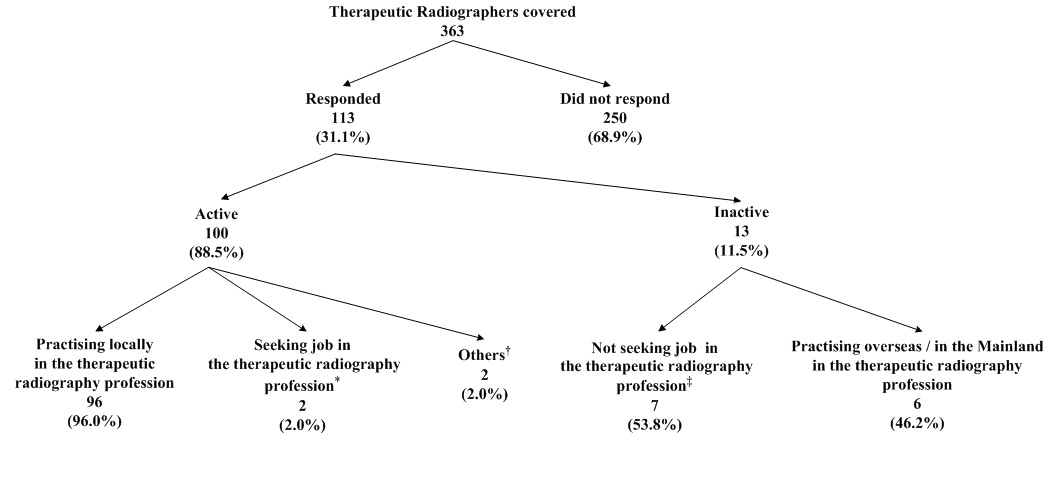
|
Note:
|
* | Figure refers to the number of responding therapeutic radiographer who (a) was not practising in the therapeutic radiography profession in Hong Kong during the survey period; (b) had been available for work during the seven days before the survey; AND (c) had sought work in the local therapeutic radiography profession during the 30 days before the survey. |
|
|
† | Figure refers to the number of responding therapeutic radiographers who (a) were not practising in the therapeutic radiography profession in Hong Kong during the survey period; (b) had been available for work during the seven days before the survey; AND (c) believed that work was not available or was expecting to return to the original job in therapeutic radiography profession during the 30 days before the survey. |
|
|
‡ | Figure refers to the number of responding therapeutic radiographers who reported working in other professions, engaged in household duty, retired or wanted to take rest / had no motive to work / had no financial need. |
1.2.6 Among the 96 active therapeutic radiographers enumerated, 44 (45.8%) were male and 52 (54.2%) were female, giving an overall sex ratio (males per 100 females) of 84.6. Apart from two therapeutic radiographers who did not indicate the age, the median age of the remaining 94 active therapeutic radiographers enumerated was 32.5 years. The median age of the active female therapeutic radiographers enumerated was 32.0 years and that of their male counterparts was 35.0 years.
1.2.7 The responding active therapeutic radiographers were requested to indicate the characteristics of their main jobs*. Distribution by sector for the main job showed that largest proportion 53 (55.2%) of the active therapeutic radiographers enumerated were working in the Hospital Authority, followed by 42 (43.8%) in the academic and private sectors.
1.2.8 The median age of the active therapeutic radiographers enumerated was 33.0 years for those working in the Hospital Authority, followed by the academic and private sectors (31.0 years).
* Main jobs referred to the jobs in which the therapeutic radiographers had spent most of their working time.
1.2.9 Of the 96 active therapeutic radiographers enumerated, 86.5% spent most of their working time on therapeutic stream, whilst 7.3%, 5.2% and 1.0% on administration / management, teaching and research respectively.
1.2.10 The median number of hours of work (excluding meal breaks) per week of the 96 active therapeutic radiographers enumerated was 39.0 hours. Among them, one (1.0%) therapeutic radiographer was required to undertake on-call duty (excluding normal duty) per week.
1.2.11 Of the 96 active therapeutic radiographers enumerated, 81.3% held Bachelor’s Degree, 10.4% held Diploma and 5.2% held Professional Diploma as their earliest basic qualifications.
1.2.12 Of the 96 active therapeutic radiographers enumerated, 63 (65.6%) had received / were receiving additional training. Of the 63 active therapeutic radiographers with additional training, 45 (71.4%) held Master’s Degree and five (7.9%) held Doctoral Degree as the highest qualification.
1.2.13 Of the 63 active therapeutic radiographers enumerated who had received / were receiving additional training, 51 (81.0%) had received / were receiving additional training in one field only. Among them, 54.9% had received / were receiving training in healthcare (medical imaging & radiation technology), 17.6% in healthcare management / health services management and 3.9% for each field in counselling and diagnostic radiography.
1.2.14 Among the 63 active therapeutic radiographers enumerated who had received / were receiving additional training, some of them selected more than one field of additional training. The total number of count of active therapeutic radiographers who had received / were receiving additional training was 73, in which 43.8% had received / were receiving training in healthcare (medical imaging & radiation technology), 19.2% in healthcare management / health services management and 4.1% for each field in diagnostic radiography, magnetic resonance imaging and counselling.
1.2.15 Regarding Continuing Professional Development (CPD) activities, 67 (69.8%) of the active therapeutic radiographers reported that they had participated in CPD activities in 2017, 26 (27.1%) reported no participation in any CPD activities, whilst three (3.1%) did not report whether they had participated in CPD activities or not. Among the 67 active therapeutic radiographers who had participated in CPD, the distribution of CPD credits attained in the past 12 months was: 1 to 10 credits (32.8%), 11 to 20 credits (49.3%), 21 to 30 credits (13.4%) and more than 40 credits (4.5%).
II. Trend Analysis
Comparison of findings of the 2017 HMS-RG with those surveys conducted before 2004 should be made with caution as the survey methods and reference date had been changed. With the enactment of the Radiographers (Registration and Disciplinary Procedure) Regulation (Chapter 359H), registration of the profession of radiographers commenced on 1 July 1995 while disciplinary control of the profession was effective on 1 November 1996, it is mandatory for a person practising diagnostic radiography / therapeutic radiography in Hong Kong to hold a valid practising certificate.
2.1 Diagnostic Radiographers
2.1.1 Between 2000 and 2017, the number of registered diagnostic radiographers increased from 1 208 to 1 817 (Chart C) .
Chart C : Number of Registered Diagnostic Radiographers Covered by Year (1992, 1996, 2000, 2004, 2005, 2006, 2007, 2008, 2011, 2014 and 2017)
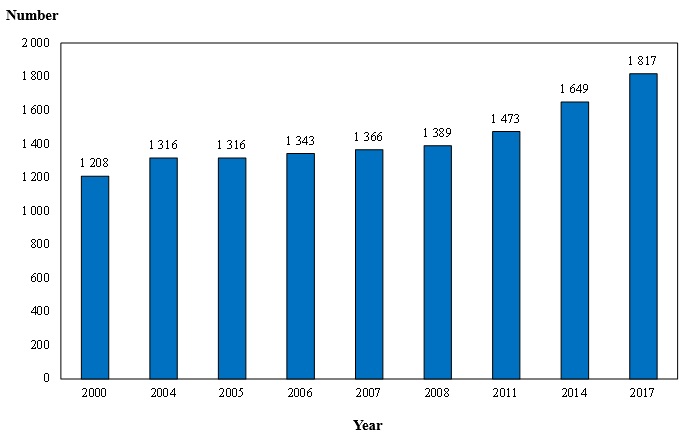
| Note: | Figure of 2000 refers to the number of diagnostic radiographers registered with the Radiographers Board of Hong Kong as at the 1 July 2000, whereas the figures of 2004 to 2017 refer to that as at the 31 March of the respective years. |
2.1.2 The sex ratio (males per 100 females) of active diagnostic radiographers enumerated decreased from 187 in 1982 to 92 in 2006, and then fluctuating in the range between 88 and 104 during 2007 to 2017 (Table A) .
2.1.3 The mean age of the active diagnostic radiographers enumerated exhibited an increasing trend from 33.0 years in 1982 to 43.9 years in 2017 (Table A) .
2.1.4 From 1982 to 1990, the Government and academic* sectors were the largest working sector of active diagnostic radiographers enumerated (68.6% to 98.7%). Since the setup of Hospital Authority in 1991, the majority were working in the Hospital Authority, with the proportion decreased from 61.4% in 1992 to around half (47.5% to 53.6%) during the period 2007 to 2017. From 2007 to 2017, the proportion of active diagnostic radiographers enumerated working in Government and academic* sectors was at around 5% to 6%. On the other hand, the proportion of active diagnostic radiographers enumerated was working in the private sector increased from 36.0% in 1992 to 47.5% in 2017 (Table A) .
* Subvented sector was included in the 1982, 1984, 1987, 1990, 2006, 2007, 2008, 2011, 2014 and 2017 HMS. Military was also included in 1987 HMS.
Table A : Selected Characteristics of Active Diagnostic Radiographers Enumerated (1982, 1984, 1987, 1990, 1992, 1996, 2000, 2004, 2005, 2006, 2007, 2008, 2011, 2014 and 2017)
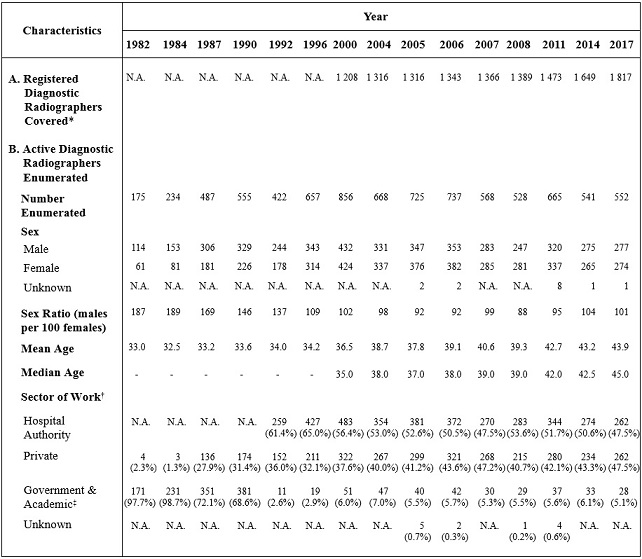
|
Note:
|
* | Figure of the 2000 refers to the number of diagnostic radiographers registered with the Radiographers Board of Hong Kong as at the 1 July 2000, whereas the figures of 2004 to 2017 refer to that as at the 31 March of the respective years. |
| † | In 2004, 2005, 2006, 2007, 2008, 2011, 2014 and 2017, the sector refers to the sector for the main job. | |
| ‡ | Subvented sector was included in the 1982, 1984, 1987, 1990, 2006, 2007, 2008, 2011, 2014 and 2017 HMS and military was also included in the 1987 HMS. | |
| There may be slight discrepancy between the sum of individual items and the total due to rounding. | ||
| N.A. Not applicable. | ||
| ‘ - ’ Not available. |
2.1 Therapeutic Radiographers
2.2.1 Between 2000 and 2017, the number of registered therapeutic radiographers increased from 179 to 363 (Chart D) .
Chart D : Number of Registered Therapeutic Radiographers Covered by Year (1996, 2000, 2004, 2005, 2006, 2007, 2008, 2011, 2014 and 2017)
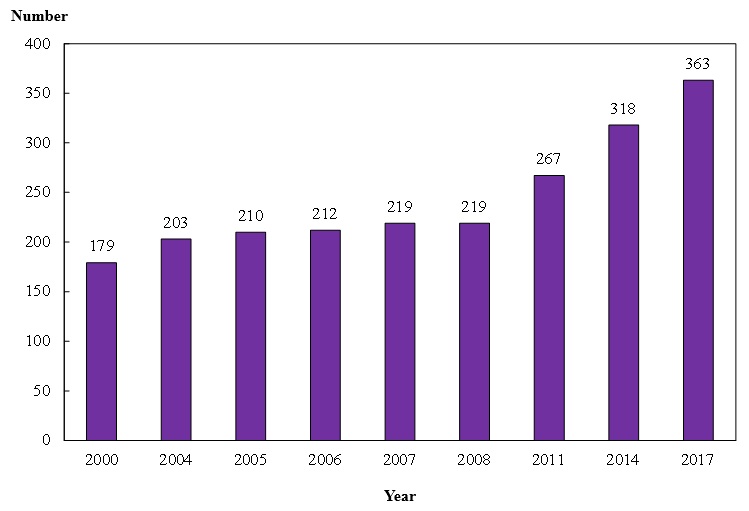
| Note: | Figure of 2000 refers to the number of therapeutic radiographers registered with the Radiographers Board of Hong Kong as at the 1 July 2000, whereas the figures of 2004 to 2017 refer to that as at the 31 March of the respective years. |
2.2.2 The sex ratio (males per 100 females) of active therapeutic radiographers enumerated has been fluctuating in the range of 122 and 280 between 1982 and 1996, and then decreased from 214 in 1996 to 85 in 2017 (Table B) .
2.2.3 The mean age of the active therapeutic radiographers enumerated had been fluctuating in the range of 31.8 years and 36.3 years between 1982 and 2017 (Table B) .
2.2.4 From 1982 to 1990, all active therapeutic radiographers enumerated were working in the Government, except that a few of them (5.3%) were working in the academic and private sectors in 1990. Since the setup of Hospital Authority in 1991, it had been the largest working sector, but the proportion of the active therapeutic radiographers enumerated decreased from 91.7% in 1992 to 55.2% in 2017. On the other hand, the proportion of active therapeutic radiographers enumerated working in the academic and private sectors increased from 8.3% in 1992 to 43.8% in 2017 (Table B) .
Table B : Selected Characteristics of Active Therapeutic Radiographers Enumerated (1982, 1984, 1987, 1990, 1992, 1996, 2000, 2004, 2005, 2006, 2007, 2008, 2011, 2014 and 2017)
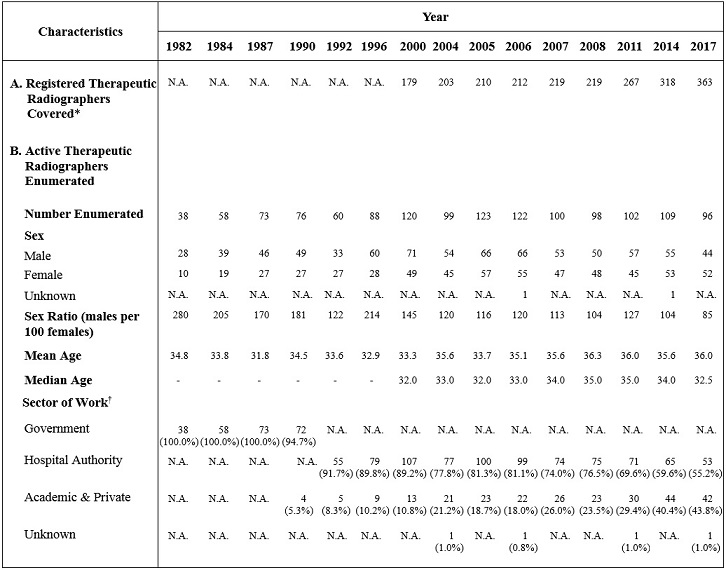
|
Note:
|
* | Figure of 1996 refers to the number of therapeutic radiographers reported by the responding institutions as at the 1 st of July 1996. Figure of 2000 refers to the number of therapeutic radiographers registered with the Radiographers Board of Hong Kong as at the 1 st of July 2000, whereas the figures of 2004 to 2014 refer to that as at the 31 st of March of the respective years. |
| † | In 2004, 2005, 2006, 2007, 2008, 2011, 2014 and 2017, the sector refers to the sector for the main job. | |
| There may be slight discrepancy between the sum of individual items and the total due to rounding. | ||
| N.A. Not applicable. | ||
| ‘ - ’ Not available. |